Easy Way to Learn Decimals and Fractions
Welcome to the final blog in the series "How to help your older child". In this blog we look at the world of fractions, decimals and percentages.
As children get older, it seems like it is a habit to remove equipment and games from teaching Mathematics. I strongly believe that as children get older it is more important to have resources and meaningful learning experiences to keep students engaged in more complex thinking and more difficult concepts. How do we achieve this? The answer needs to be by making the learning fun, interesting and important to the world of the child.
Unfortunately the teaching of fractions, decimals and percentages usually goes hand in hand with the use of worksheets and text books. Does this constitute as fun, interesting and meaningful to the child? Create a love of mathematics not a learning experience that is dreaded, with a child who is full of anxiety and an area they have no success at. (Think about your experience of Mathematics at school. Do you have a love for the subject? What engaging methods did your teachers use to help you understand mathematical concepts? - if any)
Some Facts About Teaching Fractions, Decimals and Percentages
- Try to teach them together so the child realises the relationship between all of them
- When reading a fraction always use the correct terminology eg 6/8 should be read as six eighths, not six over eight
- When reading decimals always use the correct terminology eg 0.43 should be read as 43 hundredths, not zero point four three
- Use equipment to show parts of a whole
- Fractions, decimals and percentages need to be taught as part of a whole and part of many. (eg Part of a whole - cutting up one orange and Part of many - how many of one colour lolly in a packet of colourful lollies)
Please find below a list of 15 games that children can play to develop their concepts about Fractions, Decimals and Percentages.
1. Chalk pictures
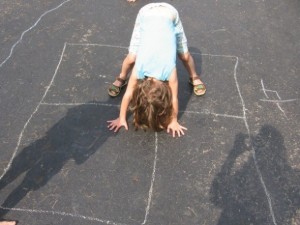 Children draw a variety of shapes and divide them up into equal sections. Once they have divided up a shape equally they can colour some parts and say the fraction, decimal and percentage relating to their drawing.
Children draw a variety of shapes and divide them up into equal sections. Once they have divided up a shape equally they can colour some parts and say the fraction, decimal and percentage relating to their drawing.
2. Play-dough
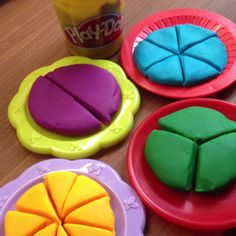 Children make shapes with play-dough and use a plastic knife to divide the shape into equal parts. Once they have divided it up equally they can remove some parts and explain using fractions, decimals and percentages terminology how much they have taken and how much they have left.
Children make shapes with play-dough and use a plastic knife to divide the shape into equal parts. Once they have divided it up equally they can remove some parts and explain using fractions, decimals and percentages terminology how much they have taken and how much they have left.
3. Fraction Bingo
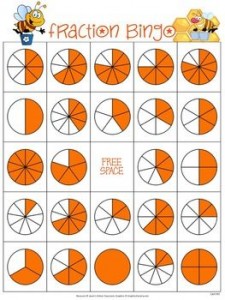 Make up a bingo card with different representations of fractions. All players have a different bingo card. All the fraction cards are placed in a bag and the caller picks one at a time out. The caller reads the fraction out and players cover up the relevant fraction if it appears on their board. First player with all their fraction pictures covers calls out bingo and becomes the winner.
Make up a bingo card with different representations of fractions. All players have a different bingo card. All the fraction cards are placed in a bag and the caller picks one at a time out. The caller reads the fraction out and players cover up the relevant fraction if it appears on their board. First player with all their fraction pictures covers calls out bingo and becomes the winner.
4. Fraction picture
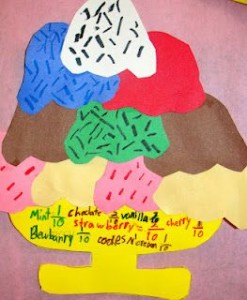 Children can make a picture (eg ice-cream bowl) with a variety of colours/flavours. After they complete it, they must describe the amount of colours using the fractions, decimals and percentage terminology. EG 20% of my ice-cream is chocolate or two fifths of my ice-cream is chocolate. (start with objects out of 10 to make it easier)
Children can make a picture (eg ice-cream bowl) with a variety of colours/flavours. After they complete it, they must describe the amount of colours using the fractions, decimals and percentage terminology. EG 20% of my ice-cream is chocolate or two fifths of my ice-cream is chocolate. (start with objects out of 10 to make it easier)
5. Colour fractions
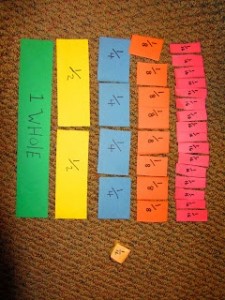 Get your child to cut five equal paper strips using a different colour for each. They can then cut each one up in different ways ensuring that each section of the strip is equal. They can cut one strip in half, one in thirds, one in quarters, one in fifths etc. Let them experiment with more strips. They can paste them all next to each other to help them understand equivalent fractions. EG, A half is the same as two quarters.
Get your child to cut five equal paper strips using a different colour for each. They can then cut each one up in different ways ensuring that each section of the strip is equal. They can cut one strip in half, one in thirds, one in quarters, one in fifths etc. Let them experiment with more strips. They can paste them all next to each other to help them understand equivalent fractions. EG, A half is the same as two quarters.
6. Clothesline
 Cut up some cardboard and write a variety of fractions, decimals and percentages on them. Give them to your child and see if they can peg them up on string from lowest to highest. They may need to peg some underneath each other to show that they are the same. This will help them with transferring their knowledge to a number line.
Cut up some cardboard and write a variety of fractions, decimals and percentages on them. Give them to your child and see if they can peg them up on string from lowest to highest. They may need to peg some underneath each other to show that they are the same. This will help them with transferring their knowledge to a number line.
7. Puzzles
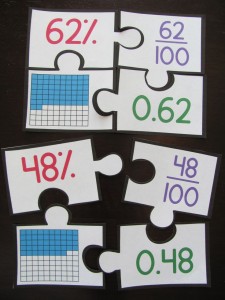 Have children create their own puzzles that match the same fraction, decimal or percentage together. They may even make up a few and give it to somebody else to put back together.
Have children create their own puzzles that match the same fraction, decimal or percentage together. They may even make up a few and give it to somebody else to put back together.
8. Bottle caps
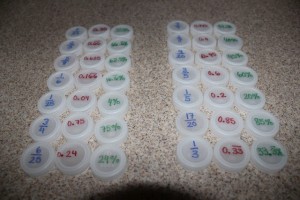 Write a variety of fractions, decimals and percentage on the back of bottle caps. Hide all the caps around the room or house. Your child must find all caps (make sure you tell your child how many there are) and then pair up caps that mean the same thing. EG two quarters and 50%.
Write a variety of fractions, decimals and percentage on the back of bottle caps. Hide all the caps around the room or house. Your child must find all caps (make sure you tell your child how many there are) and then pair up caps that mean the same thing. EG two quarters and 50%.
9. Dominoes
 Create fractions, decimals and percentages dominoes out of cardboard. Children need to put the dominoes next to each other that mean the same.
Create fractions, decimals and percentages dominoes out of cardboard. Children need to put the dominoes next to each other that mean the same.
10. Deck of cards
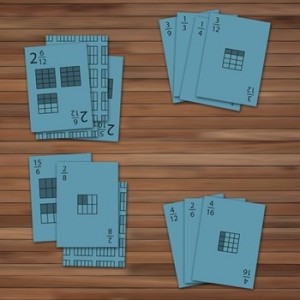 Make your own set of playing cards but use fractions, decimals or percentages. Get children to play go fish or memory or pairs with these cards. This will help children to read the fraction, decimal or percentage properly.
Make your own set of playing cards but use fractions, decimals or percentages. Get children to play go fish or memory or pairs with these cards. This will help children to read the fraction, decimal or percentage properly.
11. Expanded decimals
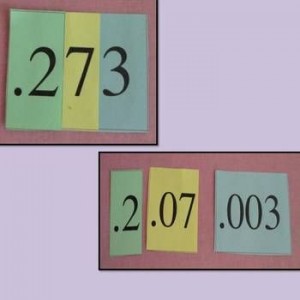 Make up a variety of decimals using tenths, hundredths and thousandths. Pick a colour for each place value, EG Tenths are green. Get your child to select 2 or 3 cards - they must be different colours. Put them together and read the decimal. Take them apart and start again.
Make up a variety of decimals using tenths, hundredths and thousandths. Pick a colour for each place value, EG Tenths are green. Get your child to select 2 or 3 cards - they must be different colours. Put them together and read the decimal. Take them apart and start again.
12. Decimal cups
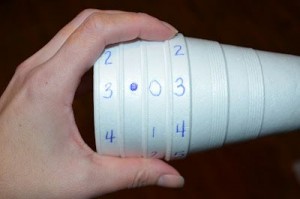 Using styrofoam cups, write numbers 0-10 around the rim. One cup will need to have a decimal point. One person calls out a decimal eg 3 and 23 hundredths. The child must make this using the cups.
Using styrofoam cups, write numbers 0-10 around the rim. One cup will need to have a decimal point. One person calls out a decimal eg 3 and 23 hundredths. The child must make this using the cups.
13. Ordering decimals
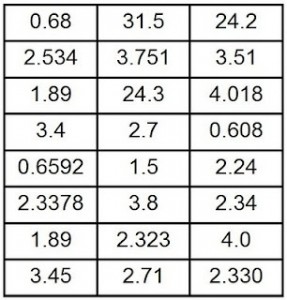 Have a variety of decimal numbers written. Children can work independently or in pairs to order the numbers from smallest to largest. They could work out where each number would go on a number line and use equipment to represent the decimal.
Have a variety of decimal numbers written. Children can work independently or in pairs to order the numbers from smallest to largest. They could work out where each number would go on a number line and use equipment to represent the decimal.
14. Food bag
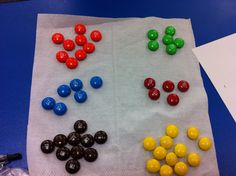 Put a variety of coloured lollies in a mystery bag. The child tips out the contents of the bag and groups matching colours together. They could then describe the bag using fractions, decimals and percentages.
Put a variety of coloured lollies in a mystery bag. The child tips out the contents of the bag and groups matching colours together. They could then describe the bag using fractions, decimals and percentages.
15. Plastic eggs
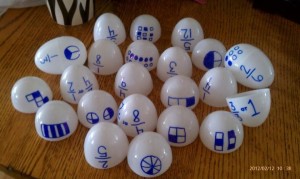 Use a plastic egg that can be separated in half. Write a fraction, decimal or percentage on one half and a matching one on the other. Do this for as many eggs that you have. Take all the eggs apart, mix them up and get your child to match the correct ones together.
Use a plastic egg that can be separated in half. Write a fraction, decimal or percentage on one half and a matching one on the other. Do this for as many eggs that you have. Take all the eggs apart, mix them up and get your child to match the correct ones together.
Hopefully these 15 games will help your children to be engaged and enthusiastic towards learning fractions, decimals and percentages. Knowing the relationship between them all, will help children solve mathematical problems.
Please share this blog if you have found it insightful and if you believe it offers practical information that your can implement at home or in the classroom. Remember to email a copy of it to yourself for reference later on.
Until next time …
Kelly Pisani
Click here to email this post to yourself or a friend
It's only fair to share...

Source: https://creatingalearningenvironment.com/15-ways-to-learn-fractions-decimals-and-percentages/
Belum ada Komentar untuk "Easy Way to Learn Decimals and Fractions"
Posting Komentar